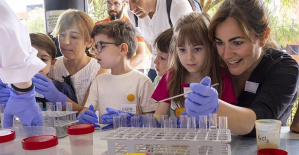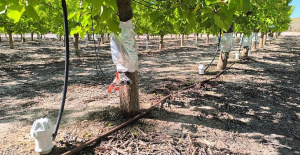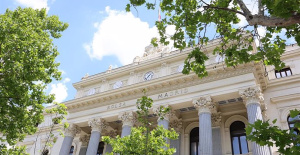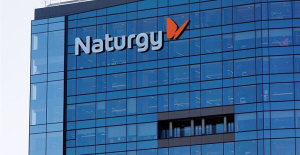VALENCIA, 5 Mar. (EUROPA PRESS) -
The European Union is outlining a new regulatory framework for green hydrogen with the prospect that by 2030 the use of the electrolysers with which it is obtained will be deployed on a massive scale, and that they must be connected to a renewable energy source.
The "main challenge" to meet this objective "is economic", since "hydrogen connected to renewable sources is very expensive", but the Valencian Community has "great potential" for its deployment. Strategic industries, such as ceramics, can benefit directly, as explained to Europa Press by the head of Hydrogen at the Technological Institute of Energy (ITE), Razvan Valentín Stoica, who from the technology center works on 'Road4Hydrogen', one of the projects deployed to "reduce prices" for this conversion.
"The first step is to try to make the hydrogen that we already consume green" because "hydrogen is not something new, although it may sound like such. In Spain, in 2019, 500,000 tons of hydrogen were consumed per year. It is a raw material, an energy vector -not an energy source- that is widely used in the industry", but "until now it was obtained easily and, above all, cheaply, from a reforming of natural gas, with "some CO2 emissions that must be reduced", the expert explained.
In this sense, according to the delegated acts recently published by the European Commission, green hydrogen will be considered that which is obtained from electrolyzers connected to production from renewable energy sources or from fossil fuels if it generates 70% fewer emissions. of greenhouse gases than fossil natural gas over its entire life cycle.
The new European guidelines will be accompanied by investments. The European Commission gave its go-ahead for Spain and other countries to invest 5,200 million euros. The Government will launch a new call for 150 million to promote pioneering projects and another 150 million for the value chain, of which 100 correspond to large electrolysers. It has also provisionally approved aid to promote green hydrogen for 250 million euros in the Perte ERHA.
The ITE expert points out that "now more than ever is being financed by Europe" and that "enough money" has been put on the table but "to some extent not comparable to what it costs" to transform the facilities. "Aid from Europe is important but it has to be accompanied by industrial or business investment at the same level and even more," he commented.
In Spain, "they are trying to make hydrogen valleys in different parts of the geography and the Valencian Community is working on this, in the famous Renewable Hydrogen Strategy of the Valencian Community in which ITE has participated", explains Stoica, who It also recalls that the first renewable hydrogen corridor in the European Union, the so-called H2Med, will pass through the Community.
"Green hydrogen is obtained from renewable sources and has no associated emissions. At ITE we focus on obtaining it using electrolyzers: you provide electrical current to the water and, through the electrolyzer, you dissociate the water molecule into hydrogen and oxygen. In the end, you have two elements, oxygen, which is an interesting raw material, and hydrogen, which is more valuable.We specialize in PEM technology, which consists of generating green hydrogen with PEM electrolyzers and consuming it with PEM fuel cells, and in technology alkaline, which are the most mature and are being used the most today", explains Razvan Valentín Stoica. These technologies are implemented in the ITE's hydrogen production pilot plant.
In this line, and with the focus on solving the economic challenge, the 'Road2Hydrogen' project, financed by Ivace, aims precisely to facilitate this connection of electrolysers to renewable energy production. "The objective is to contribute to developing production and consumption technologies and its main lines are the development and characterization of components, the modeling and digitalization of processes", explains the person in charge of ITE.
Specifically, they want to dispense with expensive precious metals by "developing and characterizing membranes, which would be the heart of the PEM-type electrolyser or fuel cell"; also "addressing the challenge of how to couple hydrogen to renewables" using "digital twins" of physical plants and that allow anticipating and predicting the needs of production facilities.
With digital twins, "I have physical equipment and a computer program that will behave exactly the same when faced with the same 'inputs'. Knowing that tomorrow I will need as much production and the energy that I will have, I can determine beforehand how my equipment will work and I economically optimize my production", explains the ITE specialist.
The project started in July 2022 and will conclude in June of this year. Components have been developed and are being tested and the digital models are already executed and their behavior is being evaluated. The ITE pilot plant is being digitized and sensorized to be able to analyze its behavior remotely from a common computer.
ITE experts are collaborating with Valencian transport, component development and, above all, renewable energy generation companies, to make it easier for the industrial fabric to connect its electrolysers to a renewable source. Thus, within the framework of the project, the needs of the companies are identified and solutions are proposed.
Stoica has highlighted the "potential" of the Community for the deployment of hydrogen, as he explains that a hydrogen project depends, on the one hand, on the availability of water, and in the Community there is no drought; wind or solar availability, of which "we can feel proud" and, "most importantly, consumers". "If there are no consumers, there are no producers," he sums up.
In this sense, he stressed that the Valencian Community has a "broad and varied" industrial fabric, which includes chemical industries that are already using hydrogen and "are going to make it green"; the ceramic sector, with "a lot of potential" and in which hydrogen can replace gas as a combustion element, and a Port of Valencia, a benchmark in the Mediterranean. "Everyone is already working, little by little, on this decarbonization by means of hydrogen," he indicated.
"What is clear is that in the Valencian Community hydrogen is here to stay and there are very interesting projects underway. Little by little more industries need to adopt it", he concluded.

 Exploring Cardano: Inner Workings and Advantages of this Cryptocurrency
Exploring Cardano: Inner Workings and Advantages of this Cryptocurrency Seville.- Economy.- Innova.- STSA inaugurates its new painting and sealing hangar in San Pablo, for 18 million
Seville.- Economy.- Innova.- STSA inaugurates its new painting and sealing hangar in San Pablo, for 18 million Innova.- More than 300 volunteers join the Andalucía Compromiso Digital network in one month to facilitate access to ICT
Innova.- More than 300 volunteers join the Andalucía Compromiso Digital network in one month to facilitate access to ICT Innova.-AMP.- Ayesa acquires 51% of Sadiel, which will create new technological engineering products and expand markets
Innova.-AMP.- Ayesa acquires 51% of Sadiel, which will create new technological engineering products and expand markets Óscar Díaz wins the 'Pasapalabra' jackpot and takes home more than 1.8 million euros
Óscar Díaz wins the 'Pasapalabra' jackpot and takes home more than 1.8 million euros Junqueras announces that he will leave the Presidency of ERC temporarily after the European elections
Junqueras announces that he will leave the Presidency of ERC temporarily after the European elections STATEMENT: Narxoz University continues academic transformation in 2024
STATEMENT: Narxoz University continues academic transformation in 2024 Prosecutor's Office opens criminal investigation proceedings for the "racist" tweets of a Vox de València councilor
Prosecutor's Office opens criminal investigation proceedings for the "racist" tweets of a Vox de València councilor How Blockchain in being used to shape the future
How Blockchain in being used to shape the future Not just BTC and ETH: Here Are Some More Interesting Coins Worth Focusing on
Not just BTC and ETH: Here Are Some More Interesting Coins Worth Focusing on UPV researchers bring their new method to achieve ultra-resistant buildings to the cover of 'Nature'
UPV researchers bring their new method to achieve ultra-resistant buildings to the cover of 'Nature' The CSN finances an IFIC project to evaluate a technology that improves nuclear waste management
The CSN finances an IFIC project to evaluate a technology that improves nuclear waste management Expociència expects to receive more than 4,000 visitors in the Science Park of the University of Valencia
Expociència expects to receive more than 4,000 visitors in the Science Park of the University of Valencia They develop devices for the precise diagnosis of cancer patients
They develop devices for the precise diagnosis of cancer patients A million people demonstrate in France against Macron's pension reform
A million people demonstrate in France against Macron's pension reform Russia launches several missiles against "critical infrastructure" in the city of Zaporizhia
Russia launches several missiles against "critical infrastructure" in the city of Zaporizhia A "procession" remembers the dead of the Calabria shipwreck as bodies continue to wash up on the shore
A "procession" remembers the dead of the Calabria shipwreck as bodies continue to wash up on the shore Prison sentences handed down for three prominent Hong Kong pro-democracy activists
Prison sentences handed down for three prominent Hong Kong pro-democracy activists ETH continues to leave trading platforms, Ethereum balance on exchanges lowest in 3 years
ETH continues to leave trading platforms, Ethereum balance on exchanges lowest in 3 years Investors invest $450 million in Consensys, Ethereum incubator now valued at $7 billion
Investors invest $450 million in Consensys, Ethereum incubator now valued at $7 billion Alchemy Integrates Ethereum L2 Product Starknet to Enhance Web3 Scalability at a Price 100x Lower Than L1 Fees
Alchemy Integrates Ethereum L2 Product Starknet to Enhance Web3 Scalability at a Price 100x Lower Than L1 Fees Mining Report: Bitcoin's Electricity Consumption Declines by 25% in Q1 2022
Mining Report: Bitcoin's Electricity Consumption Declines by 25% in Q1 2022 Oil-to-Bitcoin Mining Firm Crusoe Energy Systems Raised $505 Million
Oil-to-Bitcoin Mining Firm Crusoe Energy Systems Raised $505 Million Microbt reveals the latest Bitcoin mining rigs -- Machines produce up to 126 TH/s with custom 5nm chip design
Microbt reveals the latest Bitcoin mining rigs -- Machines produce up to 126 TH/s with custom 5nm chip design Bitcoin's Mining Difficulty Hits a Lifetime High, With More Than 90% of BTC Supply Issued
Bitcoin's Mining Difficulty Hits a Lifetime High, With More Than 90% of BTC Supply Issued The Biggest Movers are Near, EOS, and RUNE during Friday's Selloff
The Biggest Movers are Near, EOS, and RUNE during Friday's Selloff Global Markets Spooked by a Hawkish Fed and Covid, Stocks and Crypto Gain After Musk Buys Twitter
Global Markets Spooked by a Hawkish Fed and Covid, Stocks and Crypto Gain After Musk Buys Twitter Bitso to offset carbon emissions from the Trading Platform's ERC20, ETH, and BTC Transactions
Bitso to offset carbon emissions from the Trading Platform's ERC20, ETH, and BTC Transactions Draftkings Announces 2022 College Hoops NFT Selection for March Madness
Draftkings Announces 2022 College Hoops NFT Selection for March Madness























